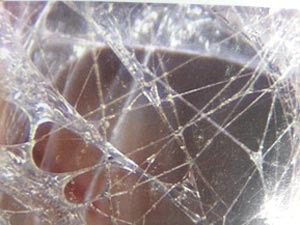
Fascia
Studies & Articles
Article: "Effects of myofascial release leg pull and sagittal plane isometric contract-relax techniques on passive straight-leg raise angle", by Hante WP & chandler SD. Published in J Orthop Sport Phys Ther in 1994
An abstract, "Myofascial release provides symptomatic relief from chest wall tenderness occasionally seen following lumpectomy and radiation in breast cancer patients" by JS Crawford, J Simpson and P Crawford published in Int J Radiat Oncol Biol Phys, 1996.
Judith O’Connel, published an article in Technique in Orthopedics, March 2003 titled "Bioelectric Responsiveness of Fascia: A Model for Understanding the Effects of Manipulation" summarizes: Fascia, the largest component of white fibrous tissue, contains linear sheets of collagen found in superficial, deep, and subserous layers. Collagen is piezoelectric, functioning as a transducer of mechanical and electrical energy. Electrical impulses are generated int eh collagen by compressive and distraction forces within the musculoskeletal system. These impulses trigger a cascade of cellular, biomechanical, natural, and extracellular events as the body adapts to external stress.
Article, "Effectiveness of Myofascial release in Treatment of Plantar Fasciitis: A RCT" by Suman Kuhar, Khatri Subhash, Jeba Chitra published in 2007 in the Indian Journal of Physiotherapy and Occupation Therapy.
An article in the J Manipulative Physiol Ther in 2008, "Effects of myofascial release after high-intensity exercise: a randomized clinical trial", by M Arroyo-Morales, N Olea, M Martinez, C Moreno-Lorenzo, L Diaz-Rodriguez, & A Hidalgo-Lozano
The full-text article, "Psychophysiological effects of massage-myofascial release after exercise: a randomized sham-controlled study", by Manuel Arroyo-Morales, et. al and published in The Journal of Alternative and Complementary Medicine in 2008
"Fascial Manipulation for chronic specific low back pain; a single-blinded randomized controlled trial" from 2015
An article by Benjamin Asher, Complementary and Integrative Treatments: The Voice, published in 2013 concluded: “Myofascial release and laryngeal massage are effective in improving vocal function and helping minimize throat pain.”
An article in Musculoskelet Sci Pract 2017, titled "Mechanical deformation of posterior thoracolumbar fascia after myofascial release in healthy men: A study of dynamic ultrasound imaging"
Tidbits, Updates and Resources
Videos
Donna Bagels presents a 27-minute video showing myofascial length test of the superficial front fascia (extensor halluces longus/brevis)
How to relieve foot pain using myofascial release by ACEFitness, 6:31 minutes.
Anatomy
A brief animated review of the body by GetBodySmart for the tensor fascia lata is a helpful review of origin, insertion and action.
An excellent description of fascia of the abdomen and pelvis, by G. G. Gallaudet can be found at scribd.com
An article in Cancer Res 2016, Connecting (T)issues: How Research in Fascia Biology Can Impact Integrative Oncology, states “Recent advances in cancer biology are underscoring the importance of connective tissue in the local tumor environment. Inflammation and fibrosis are well-recognized contributors to cancer, and connective tissue stiffness is emerging as a driving factor in tumor growth. Physical-based therapies have been shown to reduce connective tissue inflammation and fibrosis and thus may have direct beneficial effects on cancer spreading and metastasis. Meanwhile, there is currently little knowledge on potential risks of applying mechanical forces in the vicinity of tumors.”
An article in J Craniofac Surg 2017 titled Anatomy of the Platysma Muscle is an excellent quick review.
Resources
Below is a listing of some thesis/dissertations that may be accessed through professional libraries

Fascia
Studies & Articles
A literature review conducted at the University of North Carolina at Chapel Hill: What the Science Really Says: Self-Myofascial Release
Study published in the European Journal of Pain in Sept 2015 titled Effects of Compression at Myofascial trigger points in patients with acute low back pain: A randomized controlled trial
Article, published in Rheumatology in March 2015, titled A critical evaluation of the trigger point phenomenon
Article published in the Journal of Bodywork Movement Therapies in Jan 2015, titled Effectiveness of myofascial release: systematic review of randomized controlled trials
Article, published in the Clinical Journal of Pain in Sep 1994 titled Referred pain of peripheral nerve origin: an alternative to the “myofascial pain” construct
An article published in Journal of Bodywork and Movement Therapies in Jul 2011 titled Pandiculation: nature’s way of maintaining the functional integrity of the myofascial system?
Article, published in Current Pain Headache report Oct 2012, titled Etiology of Myofascial Trigger Points
Tidbits, Updates and Resources
Videos
Anatomy
Treatments
An article in Journal of Hand Therapies, Jan-Mar 2016, titled Kinesio Taping and manual pressure release: short-term effects in subjects witih myofascial trigger points